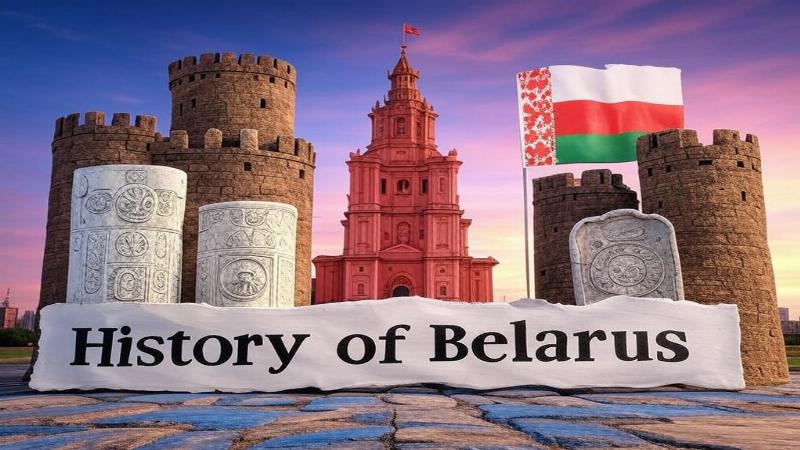Place for ads

Belarus, a landlocked nation in Eastern Europe, is a country where history whispers through its forests and cities. Spanning 207,600 square kilometers, it sits between Russia, Ukraine, Poland, and the Baltics, its flat plains and rivers shaping its destiny. Known today for its Soviet echoes and strongman rule, Belarus boasts a past that stretches back over a millennium, marked by ancient states, foreign dominion, and a quiet resilience. In this article, we’ll journey through Belarus’ history, from its earliest days to its modern identity, uncovering the forces that have defined this often-overlooked nation.
Belarus’ human story begins in the Paleolithic era, around 100,000 BCE, with evidence of hunter-gatherers in the Pripyat Marshes and along the Dnieper River. Flint tools and mammoth bones from sites like Berdyzh reveal their presence. By the Neolithic period (circa 5000 BCE), farming took root, with tribes cultivating millet and raising cattle.
The Bronze Age (2000 BCE) brought Indo-European migrations, likely ancestors of the Balts and Slavs. Iron Age cultures, like the Milograd (7th–1st centuries BCE), left pottery and hill forts, hinting at organized societies. By the 5th century CE, East Slavic tribes—Dregovichs, Krivichs, Radimichs—settled the region, laying Belarus’ ethnic foundation.
Place for ads
In the 9th century, Belarus joined Kievan Rus, a vast East Slavic state centered in Kyiv. Cities like Polotsk emerged as trade hubs along the Dvina River, linking the Baltic to the Black Sea. Princess Rogneda and her son Izyaslav made Polotsk a semi-independent principality by the 10th century, its St. Sophia Cathedral rivaling Kyiv’s.
Christianity arrived in 988 with Vladimir the Great’s baptism, spreading slowly into Belarus. The 1240 Mongol invasion shattered Kievan Rus, leaving its western lands—like Belarus—vulnerable. By the 14th century, the Grand Duchy of Lithuania absorbed the region, marking a new chapter of cultural fusion.
The 1386 union of Lithuania and Poland, cemented by the 1569 Union of Lublin, created the Polish-Lithuanian Commonwealth, one of Europe’s largest states. Belarus—then called “White Rus” or “Ruthenia”—thrived as its heartland. Minsk, granted city rights in 1499, grew alongside Brest and Grodno, fueled by trade and crafts.
The Commonwealth blended Belarusian, Polish, and Lithuanian cultures—Belarusian was an official language, and nobles like the Radziwiłł family built palaces like Nesvizh. Yet, wars—like the 1654–1667 Russo-Polish War—devastated the land, halving its population. The 1795 Third Partition dissolved the Commonwealth, handing Belarus to Russia.
Under the Russian Empire, Belarus became part of the “Pale of Settlement,” home to a large Jewish population restricted by anti-Semitic laws. Minsk, dubbed “the Jerusalem of the North,” buzzed with Yiddish culture. Tsarist policies Russified the region—Belarusian language and Orthodox faith were suppressed, though serfdom’s 1861 abolition spurred modest growth.
The 19th century saw uprisings—like the 1830 and 1863 Polish-led revolts—but Russia tightened control. Industrialization lagged, leaving Belarus rural. World War I ravaged it—German occupation in 1915–1918 displaced thousands, setting the stage for a brief bid for independence.
In March 1918, as Russia reeled from revolution, the Belarusian People’s Republic (BNR) declared independence in Minsk. Led by intellectuals like Anton Luckievich, it aimed to revive Belarusian culture. Yet, it lacked arms and recognition—German withdrawal and Bolshevik advance crushed it by 1919, splitting Belarus between Soviet Russia and Poland.
The 1921 Treaty of Riga formalized this divide—western Belarus went to Poland, eastern Belarus became the Belarusian Soviet Socialist Republic (BSSR). The BNR’s legacy endured, its white-red-white flag a symbol of resistance revived in 1991.
The BSSR joined the Soviet Union in 1922, transforming under Stalin. Collectivization forced peasants onto farms, while factories rose in Minsk and Gomel. The 1930s purges killed or exiled thousands—poets like Janka Kupala faced censorship. By 1939, the Molotov-Ribbentrop Pact returned western Belarus to Soviet control.
World War II devastated Belarus. Nazi Germany invaded in 1941, occupying it until 1944. Over 2 million died—25% of the population—including 800,000 Jews in ghettos like Minsk’s. Partisans fought back, but Minsk was razed. Post-war, Belarus rebuilt, its UN founding membership in 1945 a nod to its sacrifice.
The 1950s and ’60s brought recovery—tractors from Minsk Tractor Works symbolized industrial might. Living standards rose, but Russification deepened—Belarusian faded from schools. Leaders like Pyotr Masherov (1965–1980) balanced local pride with Soviet loyalty, earning popularity until his mysterious 1980 death.
The 1986 Chernobyl disaster, just south of Belarus, irradiated 20% of its land, displacing 200,000 and sparking dissent. As the USSR weakened, nationalist stirrings grew—Zianon Pazniak’s 1988 discovery of Stalin-era mass graves at Kurapaty fueled calls for independence.
Belarus declared independence on August 25, 1991, as the Soviet Union crumbled. Stanislav Shushkevich led briefly, hosting the 1991 Belavezha Accords that dissolved the USSR. Yet, economic ties to Russia persisted. In 1994, Alexander Lukashenko won the presidency, beginning a tenure that’s lasted decades.
Lukashenko’s rule centralized power—elections grew suspect, dissent was crushed. The 1990s saw economic struggles, eased by Russian subsidies. Belarus joined the Union State with Russia in 1999, a loose alliance, while maintaining sovereignty.
Today, Belarus’ 9.4 million people navigate a Soviet-style state. Minsk, rebuilt post-war, blends concrete with green spaces. Industry—potash, machinery—drives the economy, but sanctions over human rights hit hard. The 2020 election, widely seen as rigged, sparked mass protests, brutally suppressed, yet Lukashenko clung to power with Moscow’s backing.
Culture endures—Belarusian folk songs, straw art, and cuisine like draniki (potato pancakes) thrive. Challenges—emigration, isolation—loom, but resilience shines. The 2022 Ukraine war strained ties, with Belarus hosting Russian troops, testing its neutral image.
Belarus’ history is a tale of survival—from Kievan Rus to Soviet yoke, war’s scars to modern defiance. Its plains have borne empires and uprisings, shaping a people both stoic and proud. As Belarus faces the future, its past remains a testament to endurance at Europe’s edge.
Place for ads